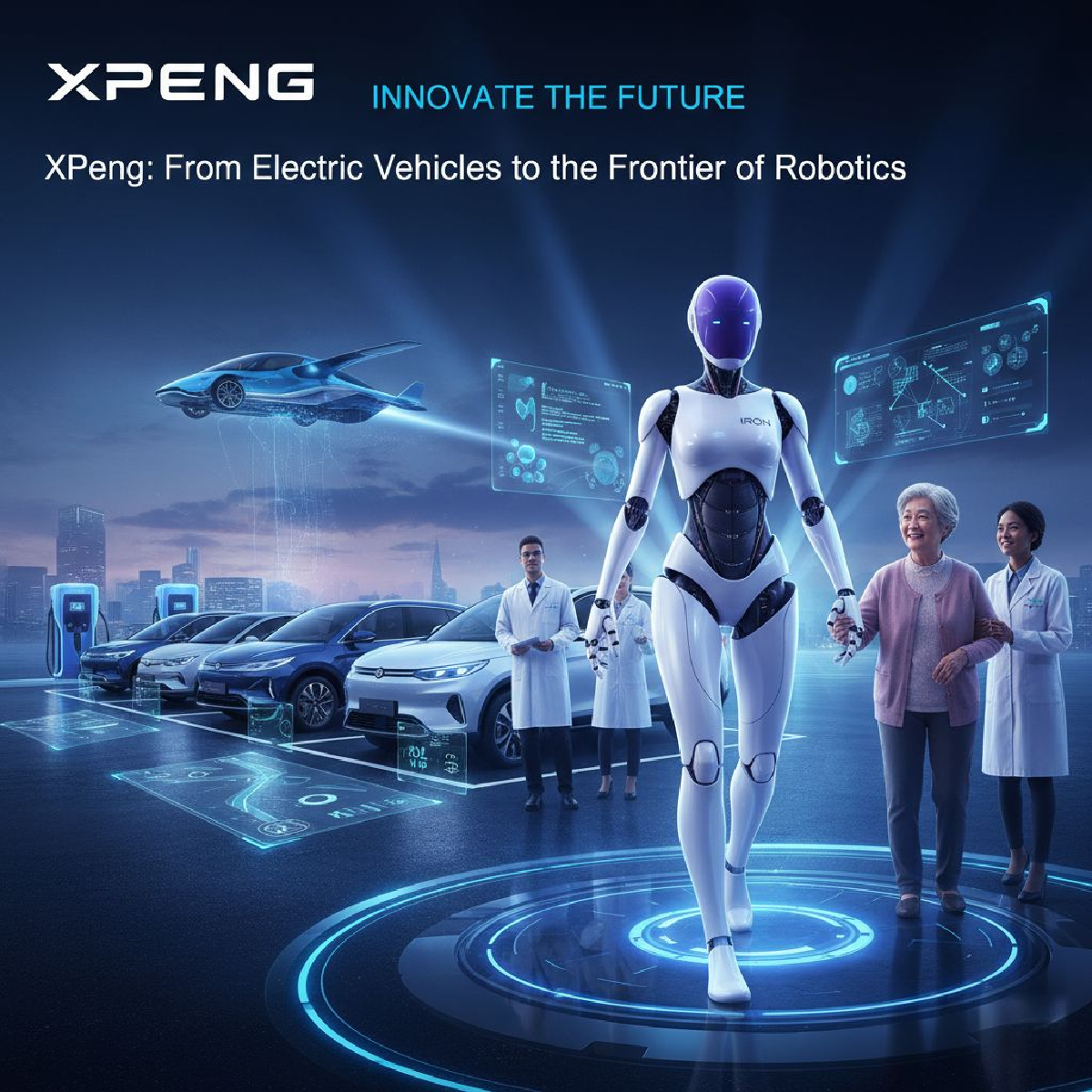He Xiaopeng built UC Web, a mobile browser, and sold it to Alibaba for $4.3 billion in 2014. He was 37, newly a billionaire, and looking for what came next.
Then Tesla opened their patents.
Most companies ignored it. He saw an opportunity. That same year, he founded XPeng Motors. The company now makes smart EVs like the G6 and G9. They’ve partnered with Volkswagen. They’re expanding globally. And like every Chinese EV startup, they’re burning cash in brutal price wars.
But that’s not why XPeng caught my attention. What interests me is their aggressive move into humanoid robotics. This isn’t a side project. They’re building production-ready robots with specs that might outpace what we’re seeing from Tesla and others.
The EV Foundation#
XPeng’s core business is electric vehicles. The numbers show growth. Triple-digit year-over-year delivery increases. Their XNGP system handles urban navigation and hands-off highway driving with genuine capability.
The Volkswagen partnership matters. VW invested $700 million for a 4.99% stake in 2023. In January 2025, they expanded it. Now they’re building an ultra-fast charging network together. Over 20,000 charging piles across 420 cities in China. Joint Volkswagen-branded EVs by 2026 using XPeng’s architecture.
Global expansion is happening. Spain in 2024. First 300 right-hand drive X9 MPVs shipped to Thailand. Ultra-fast charging networks in Southeast Asia.
But here’s the reality. Profitability remains elusive. The Chinese EV market is intensely competitive. Margins are thin. R&D spending is heavy.
He Xiaopeng says only 5 to 7 Chinese EV brands will survive. 2025 to 2027 are “elimination rounds.” This isn’t speculation. It’s the CEO telling you the house is on fire.
So they’re playing the price war game hard. March 2025: G6 price dropped 11.6% to $24,402. G9 down 5.7%. Both now include the Turing AI smart driving system at no extra cost. The G6 charges 10% to 80% in under 20 minutes.
This is the context for understanding their robotics push. They have manufacturing scale. They have experience with sensors and autonomous systems. And they need new revenue streams. Fast.
The Robotics Pivot#
XPeng started exploring robotics in 2021 with early concepts like a ridable robot unicorn. Interesting, but not particularly practical. What matters is where they are now.
November 5, 2025. AI Day in Guangzhou. XPeng unveiled the IRON humanoid robot.
Here are the specs. 178cm tall. 70kg. 82 degrees of freedom total, 22 per hand. Three AI chips delivering 2250 TOPS combined. Endoskeleton with bionic muscles. Full-body synthetic skin. Customizable appearance. First in its class to use all-solid-state batteries.
The robot is already being tested in XPeng’s Guangzhou factory. Commercial deployment targeted for retail and corporate environments in 2026.
The movement is what stands out. Natural gait. Subtle weight shifts. Fluid leg movements. Not the stiff, mechanical motion we’ve seen before.
The team cut into the leg on stage to prove no human was inside. That tells you how convincing it looks.
The system runs on in-house AI chips and solid-state batteries. XPeng’s Turing chip starts mass production Q2 2025. 750 TOPS. Three times more powerful than current chips.
This matters. XPeng controls the full stack. No dependency on external suppliers for critical components.
They’re positioning this for real applications. Elder care, including tasks most people would prefer robots handle. Industrial uses where humanoid form factors provide advantages over specialized robots. The CEO mentioned changing diapers specifically, which is both practical and revealing about their target market.
Technical Capabilities#
IRON uses vision-language-action models for autonomous movement. It perceives environment, understands context, adapts behavior. Similar approach to other robotics companies, but the execution looks more refined.
The bionic muscles enable natural movement. Traditional humanoid robots struggle with fluid motion because they use conventional motors and actuators. XPeng’s approach appears to solve some of these limitations.
The synthetic skin provides safety advantages. Robots working near humans need to minimize injury risk. Full-body covering with appropriate material properties addresses this.
The compute power is substantial. 2250 TOPS supports real-time processing of sensor data, decision-making, motor control. For comparison, that’s more than what Tesla claims for Optimus.
Competitive Position#
Public discussion positions XPeng’s humanoid as potentially superior to Tesla’s Optimus. Better compute. Better battery technology. More advanced movement quality. Polished industrial design.
Whether these advantages matter depends on execution. Demos are one thing. Production, reliability, actual deployment are different challenges entirely.
XPeng has advantages other robotics startups lack. They already manufacture complex products at scale. They understand supply chains, quality control, regulatory compliance. The EV business provides cash flow. The autonomous driving data and algorithms transfer directly to robotics.
But the risks are significant. Robotics is harder than it looks. The gap between impressive demos and products people actually buy is massive. The market for humanoid robots doesn’t clearly exist yet beyond niche applications.
Beyond Humanoids#
Robotaxis are next. November 2025: partnership with Alibaba’s Amap. Three self-developed autonomous models integrating into Amap’s platform, which already works with WeRide and Pony.ai. Trial operations begin 2026. Global robotaxi network planned, timeline unclear.
This makes strategic sense. The autonomous driving technology they’re already developing for EVs applies directly to robotaxi operations.
Then there’s the flying car. AeroHT division calls it the “land aircraft carrier.” Electric SUV with a detachable flying module that docks inside the vehicle and charges from the car’s battery. Production 2026. $280,000. He Xiaopeng claims 3-minute learning curve thanks to AI-assisted controls.
Whether it becomes practical transportation or an expensive curiosity remains to be seen.
The pattern is clear. Vertical integration around mobility. EVs provide the manufacturing foundation. Autonomous systems provide the intelligence. Robotics and flying vehicles provide future revenue opportunities. Data from all these systems feeds back into algorithm improvement through closed-loop learning.
In August 2024, they changed the company name to “XPeng AI Automobile Company.” Not subtle. They’re positioning as an AI company that happens to make cars, not a car company that uses AI.
Strategic Implications#
Here’s what XPeng illustrates. Companies with manufacturing capability and AI expertise can expand into adjacent markets faster than pure software companies can build physical products.
If IRON delivers on its promises, XPeng could capture meaningful market share before Western competitors scale their alternatives. The Chinese market provides initial volume. Global expansion follows once reliability is proven. The Turing AI system enters global adaptation phase in 2026.
The integration creates synergies pure-play robotics startups can’t match. Shared sensors. Similar AI challenges. Overlapping manufacturing processes. Common supply chains. All reduce costs and accelerate development.
But execution remains the question. Many companies have impressive robotics demos. Few ship products that actually work reliably in real-world conditions. XPeng’s EV experience helps. Robotics introduces new challenges they haven’t faced before.
The Reality Check#
Some observers see XPeng as a “Tesla-like” innovator leading where Western companies lag. Others warn about execution risks and the gap between demonstration and deployment.
Both perspectives have merit.
The technology looks genuinely advanced. The specs are competitive or superior to alternatives. The demo videos show capabilities that would have seemed impossible a few years ago.
But we’ve seen this pattern before. Impressive robotics demos that don’t translate to products. Companies pivoting into new markets and struggling with unfamiliar challenges. Technologies working in controlled environments but failing in real-world complexity.
XPeng deserves attention because they’re attempting something ambitious with apparent technical capability. Whether they actually deliver remains to be seen.
What This Means#
The robotics industry is moving faster than most people realize. XPeng, Tesla, Boston Dynamics, numerous Chinese competitors. All pushing toward practical humanoid robots. The technology is improving rapidly. Cost is decreasing. Applications are becoming clearer.
XPeng’s advantage is integration. EV business provides scale, cash, manufacturing expertise. Autonomous driving systems provide relevant AI capabilities. Willingness to invest heavily in R&D despite unprofitability shows long-term commitment.
For anyone following robotics trends, XPeng is worth tracking. Not because they’re guaranteed to succeed. Because they represent a different approach to robotics development than we’ve typically seen from Western companies.
The next few years will show whether their strategy works. If IRON ships in 2026 with the capabilities they’re claiming, the humanoid robotics market will look very different than it does today.


